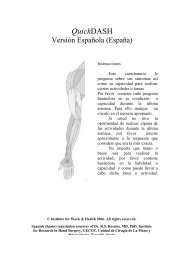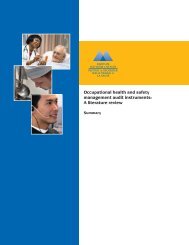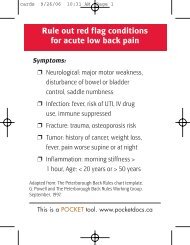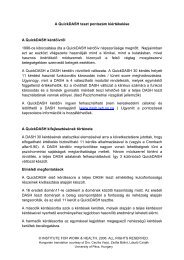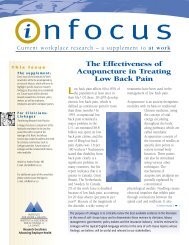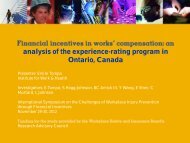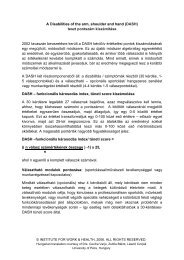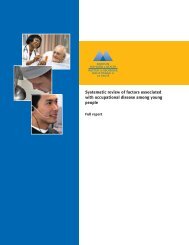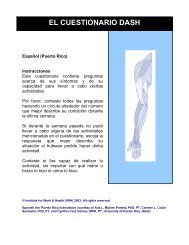A systematic review of injury/illness prevention and loss control ...
A systematic review of injury/illness prevention and loss control ...
A systematic review of injury/illness prevention and loss control ...
- No tags were found...
You also want an ePaper? Increase the reach of your titles
YUMPU automatically turns print PDFs into web optimized ePapers that Google loves.
allowed us to insure the answers provided during quality assessment wereaccurate. Any quality rating changes at this level were made with consensusfrom the primary authors <strong>of</strong> this <strong>review</strong> (S. Brewer <strong>and</strong> B. Amick). Effectsizes were not calculated due to the varied outcome measures <strong>and</strong> lack <strong>of</strong>information necessary to calculate effect sizes in some studies.Table 3: Data extraction questions1. State the research question(s)/objective(s).2. State the primary hypothesis.3. State additional hypotheses not listed in question #2.4. Write the last name <strong>of</strong> the first author <strong>and</strong> the year <strong>of</strong> publication.5. List the jurisdiction (country, state) where the study was completed.6. List the sector(s) that the study was conducted in.7. List the job titles/classification <strong>of</strong> the participants that participated inthe study.8. List the inclusion criteria described in the study.9. List the exclusion criteria described in the study.10. What is the study design?11. What type <strong>of</strong> <strong>prevention</strong> did the study investigate?12. Describe all interventions evaluated.13. Was there confirmation the intervention occurred?14. How long after the intervention implementation did confirmationoccur?15. What was the duration <strong>of</strong> the intervention in months/days/hours?16. Indicate the time period between the baseline measurement <strong>and</strong> allsubsequent follow-up measurements.17. Describe overall (study) group.18. Describe the intervention group(s).19. Describe the referent group(s).20. When were potential covariates/confounders measured?21. Provide a list <strong>of</strong> covariates/confounding variables that were <strong>control</strong>ledfor in the final test <strong>of</strong> the intervention effectiveness.22. Does the study use “administrative” records to collect measurements<strong>of</strong> <strong>injury</strong>/<strong>illness</strong> outcomes?23. Does the study use self-report records as completed by the employeeto collect measurements <strong>of</strong> <strong>injury</strong>/<strong>illness</strong> outcomes?24. Does the study use clinical diagnosis or physical exams to collectmeasurements <strong>of</strong> <strong>injury</strong>/<strong>illness</strong> outcomes?25. Was the population studied “fixed” or “open”?26. What sources were used to “count” employee injuries?27. How were employee hours collected?28. Indicate at what level employee hours were ascertained <strong>and</strong>/orestimated.29. If <strong>injury</strong> rates were calculated, list the equation(s) used.A <strong>systematic</strong> <strong>review</strong> <strong>of</strong> <strong>injury</strong>/<strong>illness</strong> <strong>prevention</strong> <strong>and</strong> <strong>loss</strong> <strong>control</strong>programs (IPCs)17



